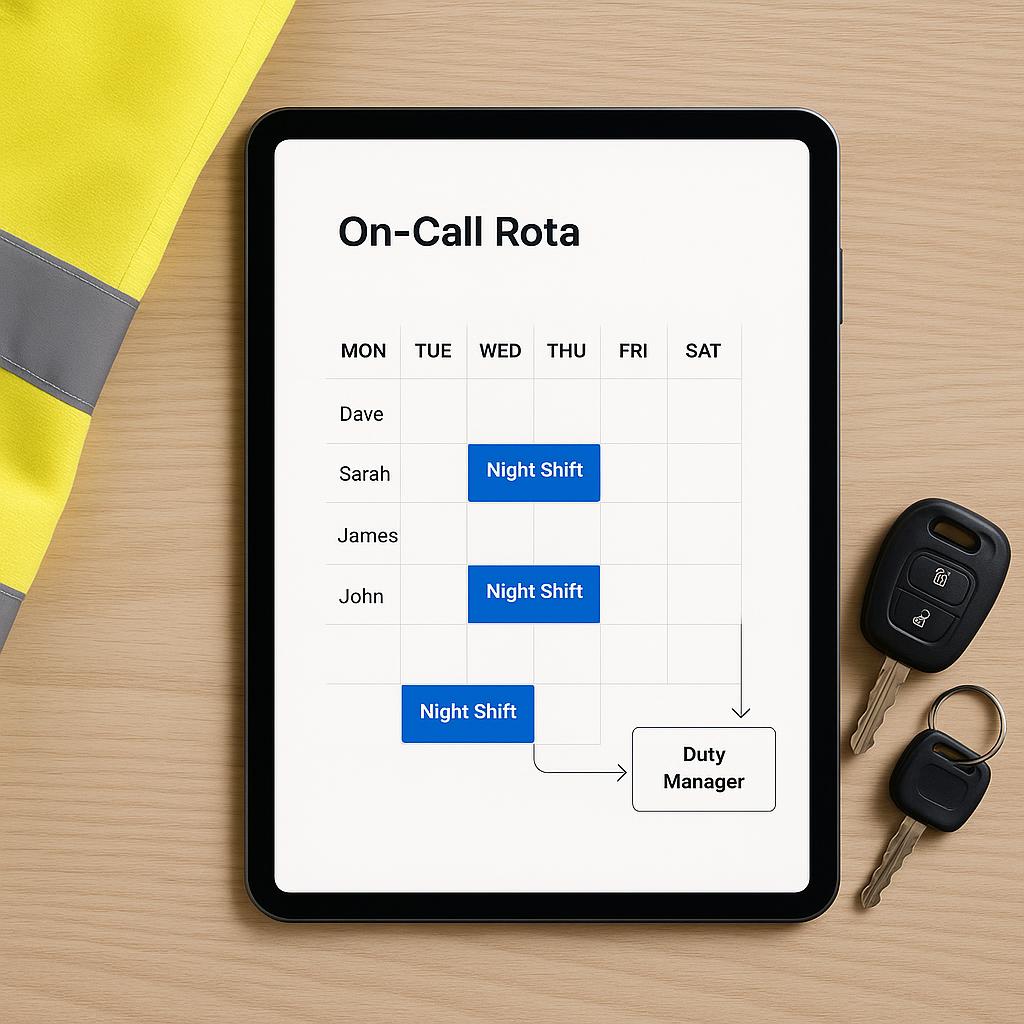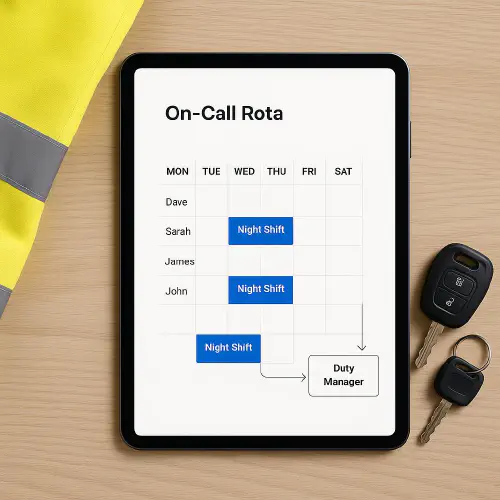
On-call rota for trades: fair pay, legal rules, escalation and a simple setup in RotaCloud
On-call rota for trades: fair pay, legal rules, escalation and a simple setup in RotaCloud
Category: Hiring, Training & HR Niche: on-call allowance, rota scheduling, escalation policy, Working Time Regulations, RotaCloud, lone working, fatigue

Tablet showing an on-call rota with night shifts and escalation flow, with hi-vis and van keys on a UK site office desk
Contents
- Quick answer
- What UK rules apply to on-call
- Pay models you can benchmark
- Set up a simple, fair on-call rota in RotaCloud
- Escalation that actually works on site
- Safety and fatigue safeguards
- Sample on-call policy you can copy
- What are people saying on Reddit
- FAQs
Quick answer
- On-call periods can count as working time depending on how restricted the person is. Time actually spent working during on-call must be paid at least the National Minimum Wage, and overtime rules apply per your contract.
- Use a clear pay structure: a small standby allowance for availability plus a minimum paid call-out block at your overtime rate is the most common for trades. Document minimum call-out duration, weekend and night multipliers, and when a rest day is granted after late calls.
- Keep rest legal: protect daily rest, weekly rest and the 48-hour average. If rest is disrupted, give compensatory rest.
- Automate the admin: build a 4 to 6 week repeating rota in RotaCloud, enable acknowledgements, and add a three-tier escalation with short timeouts so customers are not left waiting.
Helpful references: ACAS on being on call, Working Time Regulations basics, HMRC NMW manual on on-call.
What UK rules apply to on-call
- Working Time Regulations
- When on-call counts as working time
- On-call at or near the workplace, or with strict response/location limits, tends to count as working time. Being free at home with light restrictions usually does not until you actually work. See ACAS.
- Pay and National Minimum Wage
- Time spent actually working during on-call must be paid. Sleep-in rules differ; if awake and working, pay applies. Keep clean records per HMRC guidance and the HMRC internal manual.
Pay models you can benchmark
These examples show structures in use across UK organisations. Always check your contracts, any collective agreements and current handbooks.
- Standby plus minimum call-out block
- A fixed standby allowance per day or week to be available, plus a minimum paid block per call-out at 1.5x or 2x overtime depending on time and day. Common in trades and estates teams. Examples from public discussion often mention £20 to £35 per day standby and 3 to 4 hour minimums on weekends. See the Reddit examples below.
- Percentage supplements by rota intensity
- Some salaried roles use a percentage of base pay depending on how frequent the rota is, with separate payment for telephone advice and call-outs. See NHS Agenda for Change in the NHS handbook and university policies like University of Oxford allowances.
- Disturbance plus overtime
- Local authority style: a flat disturbance payment for being called plus overtime for hours worked, with minimum call-out durations. See examples from Falkirk Council and South Lanarkshire Council.
Tip: Put weekend, night and bank holiday rules in writing. State if a late finish triggers a rest day.
Set up a simple, fair on-call rota in RotaCloud
- Create a repeatable template
- Build a 4 to 6 week pattern with one Primary and one Secondary on-call per night. Save and paste across periods with Rota templates. See RotaCloud help on templates.
- Capture availability and swaps
- Ask engineers to set availability and request swaps in-app so you reduce rota conflicts and short-notice gaps. See availability.
- Acknowledge and prove attendance
- Require push notification acknowledgment when the rota is published. For call-outs, use mobile clock-ins with GPS only if necessary, and inform staff for GDPR transparency. See mobile clock-ins.
Escalation that actually works on site
Use short timeouts so customers are not stuck waiting if someone misses a call. Keep the contact list current and do handovers at shift change.
- Level 1 Primary engineer. Respond within 5 minutes.
- Level 2 Secondary engineer if not acknowledged by 10 minutes.
- Level 3 Duty manager if still unacknowledged by 20 minutes. Declare major incident if high risk.
- Lone worker overlay: welfare check at dispatch, then at 30 minutes if still on site.

On-call escalation policy diagram with Primary, Secondary and Duty Manager and a 30 minute welfare check
Further reading on escalation discipline from incident tooling vendors: PagerDuty basics and Being on-call.
Safety and fatigue safeguards
- Lone working and out-of-hours risks
- Do a simple risk assessment for night call-outs, include check-in calls and emergency steps. See HSE guidance on lone working.
- Fatigue management
- Cap consecutive on-call nights, protect daily and weekly rest, and watch travel time. For a practical scoring approach, see our guide: Construction fatigue risk management: RAG scoring, shift rules and a quick setup in Google Sheets.
- Competence and access
- Link your skills matrix to scheduling so only competent engineers are rostered for certain call types. See Skills matrix for construction: link Google Sheets to your calendar to block unsafe bookings and Automate CSCS, CPCS and SMSTS renewals.
Sample on-call policy you can copy
Use this as a starting point and adapt to your contracts and any collective agreements.
On-call definition
On-call means the employee is available outside normal hours to respond to urgent requests. The employee must be contactable by phone and able to respond within 5 minutes. If attendance is required, they must be able to travel to site within 60 minutes.
Standby allowance
A standby allowance is paid for each day or week the employee is rostered on-call. The allowance compensates for availability only and is separate from pay for time worked during call-outs.
Call-out payments
Time actually worked during on-call is paid at the employee’s overtime rate. A minimum of [3 or 4] hours is paid per call-out outside core hours. If multiple call-outs occur in a single minimum block, only one minimum is paid. Travel time counts as working time.
Night and weekend rules
Overtime multipliers apply as per the contract. Call-outs finishing after [03:00] grant a paid rest period the next day to meet Working Time Regulations; work is reallocated.
Escalation
If the Primary engineer does not acknowledge within 5 minutes, the Secondary engineer is contacted. After 20 minutes unacknowledged, the Duty Manager is contacted and may declare a major incident.
Health, safety and welfare
Lone-working procedures apply. The Duty Manager must confirm a welfare check-in on dispatch and 30 minutes after arrival if still on site. Suitable PPE and safe access must be confirmed before attending.
Records
The rota, acknowledgements, call logs, travel and time worked must be recorded for audit and National Minimum Wage compliance.
What are people saying on Reddit
Recent UK electrician reports suggest practical ranges for trades on-call:
- Example 1: £135 per week standby plus a 4 hour minimum at 1.5x or 2x for each call-out. Thread
- Example 2: Around £20 to £35 per day standby, 3 to 4 hour minimums, and rest if a call finishes afte…